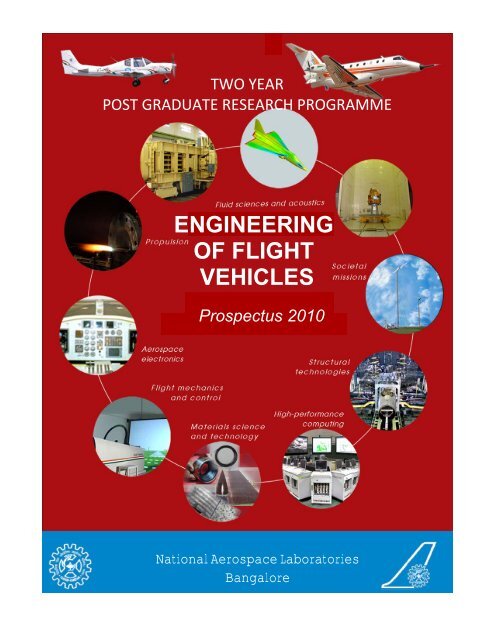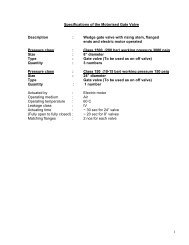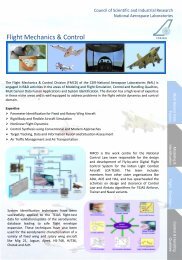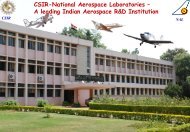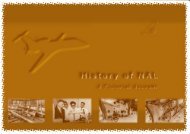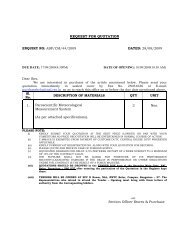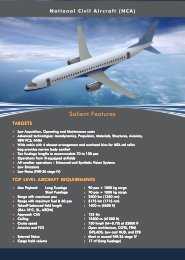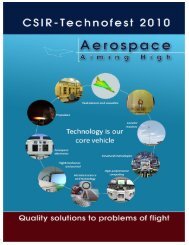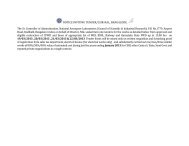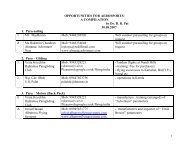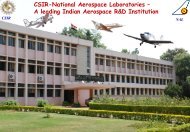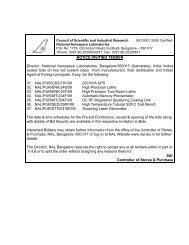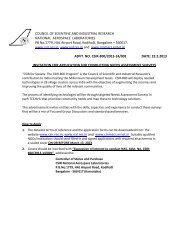engineering of flight vehicles - National Aerospace Laboratories
engineering of flight vehicles - National Aerospace Laboratories
engineering of flight vehicles - National Aerospace Laboratories
Create successful ePaper yourself
Turn your PDF publications into a flip-book with our unique Google optimized e-Paper software.
TWO YEAR<br />
POST GRADUATE RESEARCH PROGRAMME<br />
ENGINEERING<br />
OF FLIGHT<br />
VEHICLES<br />
Prospectus 2010<br />
<strong>National</strong> <strong>Aerospace</strong> <strong>Laboratories</strong><br />
Bangalore
About the Course :<br />
1. Introduction<br />
2. Eligibility for admission<br />
3. Mode <strong>of</strong> payment<br />
4. Summary <strong>of</strong> total credits<br />
5. Summary <strong>of</strong> course details – Subject wise<br />
6. Summary <strong>of</strong> course details – Semester wise<br />
7. Syllabus <strong>of</strong> course subjects<br />
8. Evaluation Procedure and Grading Scheme<br />
9. List <strong>of</strong> faculty
Two Year<br />
Post Graduate Research Program in Engineering in<br />
Engineering <strong>of</strong> Flight Vehicles<br />
at<br />
<strong>National</strong> <strong>Aerospace</strong> <strong>Laboratories</strong>, Bangalore<br />
(2010 -12)<br />
Configuration design <strong>of</strong> an aerospace vehicle is important from the consideration <strong>of</strong><br />
building an efficient vehicle. The efficiency <strong>of</strong> the vehicle is defined in terms <strong>of</strong> its<br />
stability (for better control), minimum drag at cruise (to reduce the fuel consumption),<br />
higher maneuverability (to have air superiority), better engine integration with<br />
airframe (to provide higher thrust), better fatigue life (for longer life) etc. All these<br />
encompass study in various disciplines <strong>of</strong> aeronautics namely aerodynamics,<br />
propulsion, structures and <strong>flight</strong> mechanics. A program is designed with the aim to<br />
get better understanding <strong>of</strong> these areas with reference to their application to<br />
configure the aerospace vehicle and addressing the R&D challenges associated with<br />
it to improve the effeiciency <strong>of</strong> the vehicle.<br />
The program covers broadly, the areas <strong>of</strong> aerodynamics including computational fluid<br />
dynamics and experimental techniques, <strong>flight</strong> vehicle structures, aircraft propulsion,<br />
<strong>flight</strong> mechanics and control, aerospace <strong>vehicles</strong> and systems.<br />
The two year Post Graduate Research Training Program aims to provide in depth<br />
exposure to the <strong>engineering</strong> concepts, scientific principles, research methodology<br />
and hands on experience on advanced real life R&D projects in different areas<br />
related to <strong>flight</strong> <strong>vehicles</strong>. Students completing this two years program are expected to<br />
be fully research – enabled and industry ready.<br />
The first semester <strong>of</strong> the program focuses on core subjects covering the basics in<br />
each <strong>of</strong> the area mentioned above and associated practical work in the laboratories.<br />
The second semester <strong>of</strong>fers courses which provides further an in-depth<br />
understanding <strong>of</strong> these areas related to their application to <strong>flight</strong> <strong>vehicles</strong>. The third<br />
semester <strong>of</strong>fers advanced courses which lead to understanding <strong>of</strong> R&D challenges in<br />
the respective areas. In fourth semester students will be utilizing their knowledge<br />
acquired through the courses to solve real-world design challenges by working on<br />
advanced R&D projects work and for a dissertation in their specialization areas.
Eligibility for Admission<br />
Candidates having BE/BTech or equivalent in Aeronautical/<strong>Aerospace</strong>/Mechanical<br />
Engg, completed in 2009 or graduating during 2010, with minimum 70% marks<br />
(Aggregate <strong>of</strong> all Semester/Year) or 7.0 CGPA (Aggregate <strong>of</strong> all Semester/Year) are<br />
eligible to apply.<br />
Candidates who have passed BE/BTech or equivalent in relevant discipline before<br />
2009 are not eligible to apply.<br />
Desirable Qualification: A valid GATE score will be an added advantage.<br />
Mode <strong>of</strong> Payment<br />
Tuition fee need to be deposited the fee at NAL, Bangalore before the start <strong>of</strong> every<br />
semester by making payment either by cash at NAL cash counter or through Demand<br />
Draft drawn in favour <strong>of</strong> ‘Director, NAL’ payable at Bangalore. The Demand draft to<br />
be sent by speed post or registered letter to ‘Director, <strong>National</strong> <strong>Aerospace</strong><br />
<strong>Laboratories</strong> Bangalore 560 017’ with the name <strong>of</strong> the student written in pencil on<br />
the reverse ride <strong>of</strong> the demand draft.<br />
For other details (Admission Process, Eligibility, Fellowship, Important Dates, fee<br />
structure and online application)<br />
Please visit the CSIR website http://www.csir.res.in/
COURSE DETAILS FOR CSIR PGRPE PROGRAM 2010 ON<br />
‘ENGINEERING OF FLIGHT VEHICLES’<br />
From: CSIR <strong>National</strong> <strong>Aerospace</strong> <strong>Laboratories</strong><br />
PROGRAMME DURATION: 2 years<br />
Summary <strong>of</strong> Total Subjects / Total Credits for PGRPE Course on<br />
“Engineering <strong>of</strong> Flight Vehicles”<br />
to be conducted at CSIR‐<strong>National</strong> <strong>Aerospace</strong> Laboratory in the year 2010<br />
Semester No. <strong>of</strong> Subjects No. <strong>of</strong> Credits Place<br />
1 5 17 NAL<br />
2 5 17 NAL<br />
3 5 15 NAL<br />
4 1* 15* NAL<br />
Total : 16 49 + 15 = 64<br />
∗ Project Work
Summary <strong>of</strong> Course details – Subject Wise<br />
Semester<br />
I<br />
Aerodynamics<br />
Applied<br />
Mathematics<br />
Atmospheric<br />
Flight Mechanics<br />
<strong>Aerospace</strong><br />
Vehicles and<br />
Systems<br />
Aircraft Propulsion<br />
II<br />
Gas Dynamics<br />
Flight Dynamics<br />
and Control<br />
Navigation,<br />
Guidance<br />
& Control<br />
Aircraft<br />
Performance<br />
Flight Vehicle<br />
Structures<br />
III<br />
Computational<br />
Fluid Dynamics &<br />
Experimental<br />
Techniques<br />
Exp. Flight Tech<br />
&<br />
Data Handling<br />
Flight Vehicle<br />
Design<br />
Advanced<br />
Control<br />
Structural<br />
Dynamics &<br />
Aeroelasticity<br />
IV<br />
PROJECT WORK
Semester wise subjects<br />
I SEMESTER<br />
(All Courses are Compulsory)<br />
Course Credits Course Title<br />
NALEF101 3:0 Applied Mathematics<br />
NALEF102 4:0 Aerodynamics *<br />
NALEF103 3:0 <strong>Aerospace</strong> Vehicles and Systems<br />
NALEF104 3:0 Atmospheric Flight Mechanics<br />
NALEF105 4:0 Aircraft Propulsion*<br />
* Includes practical classes<br />
II SEMESTER<br />
(All Courses are Compulsory)<br />
Course Credits Course Title<br />
NALEF201 3:0 Navigation Guidance and Control<br />
NALEF202 4:0 Gas Dynamics*<br />
NALEF203 3:0 Flight Dynamics and Control<br />
NALEF204 4:0 Flight Vehicle Structures*<br />
NALEF205 3:0 Aircraft Performance Evaluation<br />
* Includes practical classes
III SEMESTER<br />
(All Courses Compulsory)<br />
Course Credits Course Title<br />
NALEF301 3:0 Flight Vehicle Design*<br />
NALEF302 3:0 Experimental Flight Techniques<br />
and Data Handling *<br />
NALEF303 3:0 Advanced Control<br />
NALEF304 3:0 Structural Dynamics &<br />
Aeroelasticity<br />
NALEF305 3:0 Computation Fluid Dynamics<br />
and Experimental Techniques*<br />
* Includes practical classes<br />
IV SEMESTER<br />
(Project Compulsory)<br />
Course Credits Course Title<br />
NALEF401 15 Project work‐Thesis
Course Details – I Semester<br />
NALEF101 3:0 Methods <strong>of</strong> Applied Mathematics<br />
Linear Algebra (Matrices, vectors, determinants, linear systems, matrix eigenvalue<br />
problems,notion <strong>of</strong> vector spaces), Vector Calculus (grad,div,curl,integral theorems<br />
<strong>of</strong> Green, Stokes and Gauss and applications), ODEs (First order ODEs, higher order<br />
linear ODEs, notion <strong>of</strong> fundamental solutions and boundary conditions, systems <strong>of</strong><br />
ODEs, series solutions <strong>of</strong> ODEs ‐ special functions). Fourier analysis<br />
(series,integrals,transforms,applications), PDEs (basic types – elliptic, parabolic,<br />
hyperbolic), complex analysis (complex numbers and functions, complex integration,<br />
Cauchy residue theorem, power series, conformal mapping, potential theory),<br />
numerical methods (general numerics, basic numerical linear algebra like Gauss<br />
method / LU decomposition, basic numerics for ODEs / PDEs ).<br />
Kreyzig, E, Advanced Engineering Mathematics, John Wiley and Sons Inc, 2006<br />
NALEF102 4:0 Aerodynamics<br />
Concept <strong>of</strong> a velocity field, vorticity, Eulerian and Lagrangian coordinates,<br />
streamlines, streaklines and pathlines, concept <strong>of</strong> a substantial derivative, laws <strong>of</strong><br />
conservation, elementary applications <strong>of</strong> continuity and the momentum theorem<br />
control volume analysis and its application, inviscid flows and the Bernoulli<br />
equations, elements <strong>of</strong> aer<strong>of</strong>oil theory. lift and drag and their coefficients, small<br />
perturbation theory; 2‐D airfoils in subsonic and supersonic flow, Numerical<br />
methods for 2‐D airfoils; similarity rules, Multhop's method, vortex lattice and<br />
double lattice methods, effects <strong>of</strong> sweep and AR, Aerodynamics <strong>of</strong> wing ‐ fuselage<br />
system and aerodynamics <strong>of</strong> control surfaces. High angle <strong>of</strong> attack aerodynamics:<br />
non‐linear aero ‐dynamics, Unsteady aerodynamics. Five laboratory classes to<br />
demonstrate the concepts and measurements <strong>of</strong> some aerodynamics parameters.<br />
Houghton E L and Basewell R P, Further Aerodynamics for Engineers, Edward Arnold<br />
Publishing Company Holt Ashley and Landhall M, Aerodynamics <strong>of</strong> Wings and<br />
Bodies, Addison‐Wesley, 1965 R T Jones, Wing Theory, Princeton University<br />
Press,1990.<br />
NALEF103 3:0 <strong>Aerospace</strong> Vehicles and Systems<br />
Evolution <strong>of</strong> heavier‐than aircraft for several applications, passenger, transport,<br />
freight, military applications, Configurations <strong>of</strong> various types <strong>of</strong> aircraft: Fixed wing<br />
aircraft, various types <strong>of</strong> aircraft, identification <strong>of</strong> various structural parts, materials<br />
used and their functions. Interplay <strong>of</strong> aerodynamics, structural mechanics,<br />
propulsion, avionics and controls in their conceptualization and performance.<br />
Introduction to aircraft specifications: Standards for both Military and Civil aircraft,
Airworthiness certification aspects aircraft introduction to <strong>flight</strong>‐testing: Purpose<br />
and Scope <strong>of</strong> Flight Testing; introduction to general flying and handling<br />
characteristics <strong>of</strong> aircraft. Flight test plans and procedures, Flight test data<br />
acquisition, analysis and interpretation.<br />
Kermode, A C, Flight without formulae, Sterling Book House, 1970<br />
Padfield, R R Flying in Adverse Conditions, Tab Books, 1994<br />
Mair W.A. and Brasail, D L , Aircraft Performance, Cambridge <strong>Aerospace</strong> Series, 1996<br />
McCormick, B W Aerodynamics, Aeronautics and Flight Mechanics, 1995<br />
Gorffin M D, and J R French, Space Vehicle Design, AIAA Education Series<br />
Janes, All the world Aircrafts series.<br />
Anderson J D: “Introduction to Flight”‐ McGraw Hill, 1987.<br />
NALEF104 3:0 Atmospheric Flight Mechanics<br />
Systems <strong>of</strong> Axes, Euler Angles and quaternions, Axes Transformation, Static<br />
Equilibrium and Trim, Aircraft Static Stability, Contributions <strong>of</strong> Wing and Tail, Neutral<br />
Point and Static Margin, Longitudinal Stability and Control, Directional Stability and<br />
Control, Roll Stability and Control, Equations <strong>of</strong> Motion and their alternative forms,<br />
Solution <strong>of</strong> Equations <strong>of</strong> Motion, elastic airplane equations <strong>of</strong> motion, Transfer<br />
function and response characteristics, State Space Method, Aerodynamic stability<br />
and control derivatives, Aircraft modes <strong>of</strong> motion, Longitudinal and Lateral dynamic<br />
stability modes, mathematical model structure, reduced order models, frequency<br />
responses and time histories, modal analysis, eigenvalues, eigenvectors and mode<br />
shapes, maneuverability, Steady and accelerated <strong>flight</strong><br />
RC Nelson, Flight Stability and Automatic Control<br />
Babistor A.H., Aircraft Stability and Control, Pergamon Press,<br />
Elkin B., Dynamics <strong>of</strong> Atmospheric Flight, John Wiley and Sons<br />
Perkins, C. D., and Hage, R. E., Airplane Performance, Stability, and Control, John<br />
Wiley and Sons, New York<br />
NALEF105 4:0 Aircraft Propulsion<br />
Introduction to propulsive devices; Air‐breathing and Non‐airbreathing systems.<br />
Performance parameters, cycle analysis <strong>of</strong> ramjet, turbo‐jet, turb<strong>of</strong>an and turboprop<br />
engines; Afterburners. Rotating Components: centrifugal and axial compressors,<br />
axial turbines; Non‐rotating components: combustion chambers, intakes and<br />
nozzles. Five laboratory classes for showing the concepts and conducting <strong>of</strong><br />
experiments.<br />
Hill P G and Peterson C R , Mechanics and Thermodynamics <strong>of</strong> Propulsion, Addison<br />
Wesley, 1965. Kerrebrock, J L , Aircraft Engines and Gas Turbines, MIT Press, 1977<br />
Mattongly, J D, Elements <strong>of</strong> Gas Turbine Propulsion, McGraw Hill 1996<br />
Mukunda H S, Understanding Combustion.
Course Details – II Semester<br />
NALEF201 3:0 Navigation, Guidance and Control<br />
Inertial Navigation Sensors and Systems, WGS‐84 system, Concept <strong>of</strong> Uncertainty in<br />
Navigation, Kalman Filter Inertial Navigation System Flight Applications, Global<br />
Positioning System, High Accuracy Navigation Using Global Positioning System, Flight<br />
Testing Navigation Systems.<br />
Introduction to open‐ and closed‐loop control systems and examples, Differential<br />
equation models <strong>of</strong> physical systems and solution methods, choice <strong>of</strong> linear models,<br />
Laplace transforms, transfer functions, and block diagrams, State‐variable system<br />
models, relative stability, gain and phase margins, Bode plots, Nyquist stability<br />
Criterion, Nichols chart, linear design process, Root locus design methods, System<br />
bandwidth, Feedback system characteristics, Design <strong>of</strong> feedback systems in the<br />
frequency‐ and time‐domain, Observability and controllability, angle‐<strong>of</strong>‐attack<br />
limiter, sideslip angle and sideslip rate feedback, roll rate feedback, design <strong>of</strong><br />
command paths, nonlinear design and verification, basic autopilot control laws.<br />
Daniel J. Biezad, Integrated Navigation and Guidance Systems, AIAA Education<br />
Series<br />
NALEF202 4:0 Gas Dynamics<br />
Fundamentals <strong>of</strong> thermodynamics; propagation <strong>of</strong> small disturbances in gases;<br />
normal and oblique shock relations, nozzle flows; one‐dimensional unsteady flow;<br />
small disturbance theory <strong>of</strong> supersonic speeds, generation <strong>of</strong> supersonic flows in<br />
tunnels, supersonic flow diagnostics, supersonic flow over two‐ dimensional<br />
bodies; shock expansion analysis, method <strong>of</strong> characteristics; one‐dimensional<br />
rarefaction and compression waves; flow in shock tube. Five laboratory classes for<br />
demonstrating the concepts and conducting <strong>of</strong> experiments.<br />
Liepmann H W and Roshko A, Elements <strong>of</strong> Gas Dynamics, John Wiley, 1957<br />
Becker E, Gas Dynamics Academic Press, New York, 1968.<br />
John D Anderson, Modern Compressible Flow, McGraw Hill 1990<br />
NALEF203 3:0 Flight Dynamics and Control<br />
Flight Mechanics parameters, aerodynamic database, principles <strong>of</strong> simulation,<br />
sensor dynamics, high‐order actuator dynamics, engine model, landing gear model,<br />
integration into 6‐DOF simulation model, Aerodynamic Modeling, <strong>flight</strong> path<br />
reconstruction techniques, aerodynamic derivative estimation, aerodynamic<br />
database validation and update procedures, Statically unstable aircraft, control<br />
power requirements for unstable aircraft, control actuator rate requirements, limits<br />
on static instability, control surface sizing, center‐<strong>of</strong>‐gravity limits, Routh‐Hurwitz
stability criterion, root locus plot, inertia cross coupling, roll coupling, autorotation,<br />
roll reversal, Longitudinal and Lateral stability Augmentation, Pole placement<br />
method,<br />
Schmidt, L.V., Introduction to Aircraft Flight Dynamics, AIAA Education Series.<br />
McRuer, D., et al, Aircraft Dynamics and Automatic Control, Princeton University<br />
Press.<br />
Stengel, R. F. Flight Dynamics, Princeton University Press, Princeton, NJ 2004 (ISBN:<br />
0‐691‐11407‐2)<br />
NALEF204 4:0 Flight Vehicle Structures<br />
Introduction to <strong>Aerospace</strong> vehicle structures, Aircraft structural components &<br />
loads, Aircraft Materials with specific reference to composites, Airworthiness,<br />
certification and standards related to aero‐structures, Finite element structural<br />
analysis, Analysis & design <strong>of</strong> composites structures, Engineering fracture mechanics<br />
& damage tolerance, Impact and Crashworthiness, Introduction to Computer aided<br />
design (CAD) and product life cycle, management (PLM), Structural optimization :<br />
Size, shape and topology optimization, Smart structures and materials, Active<br />
structural control. Five laboratory classes showing the materials, and involvement <strong>of</strong><br />
students in conducting <strong>of</strong> experiments.<br />
C.T. Sun, 2006, Mechanics <strong>of</strong> Aircraft Structures, John Wiley and Sons, New York<br />
T.H.G. Megson, 1999, Aircraft Structures for Engineering Students, Butterworth‐<br />
Heinemann, Oxford<br />
D.V. Wallerstein, Variational Approach to Structural Analysis, John Wiley and Sons,<br />
2001<br />
I.H. Shames, C.L. Dym, Energy and Finite Element Methods in Structural Mechanics,<br />
1991,<br />
NALEF205 3:0 Aircraft Performance Evaluation<br />
Estimation <strong>of</strong> the performance: Power requirements and engine choice and size,<br />
minimum to fly level, power to climb and maneuver with typical power plants<br />
Stability characteristics <strong>of</strong> the airplane: Longitudinal and Lateral stability analysis,<br />
static margin and stabilizer sizing; Sizing and trade studies.<br />
Donald Layton, Aircraft Performance,Matrix Publishers, 1988<br />
Mair W.A. and Brasail, D L , Aircraft Performance, Cambridge <strong>Aerospace</strong> Series, 1996
Course Details – III Semester<br />
NALEF301 3:0 Flight Vehicle Design<br />
Survey <strong>of</strong> various types <strong>of</strong> Airplanes, Overview <strong>of</strong> the design process; preliminary<br />
aerodynamic design, take‐<strong>of</strong>f weight estimation, selection <strong>of</strong> wing loading, thrust<br />
loading, engine and geometrical parameters <strong>of</strong> major components Conceptual<br />
design <strong>of</strong> a <strong>flight</strong> vehicle, Airplane Layout (Three view drawings : Arrangement <strong>of</strong><br />
surfaces, Mass and Moment <strong>of</strong> Inertia properties and balance diagram) Design <strong>of</strong><br />
structural components (fuselage, wing, horizontal and vertical tail). Design aspects<br />
<strong>of</strong> subsystems: Flight control system, Landing Gear and subsystem, Propulsion and<br />
Fuel system integration, Air pressurization and air conditioning system, Electrical &<br />
Avionic system<br />
Tomas C Corke., “Design <strong>of</strong> Aircraft,” Person Education, LPE, 2003.<br />
Stinton D.,"The Design <strong>of</strong> the Aeroplane", Granada, England 1983.<br />
D. P. Raymer, "Aircraft Design, A Conceptual approach", AIAA Education Services,<br />
1992.<br />
J Roskam, Vol 1 to 9 Aeroplane Design<br />
Nicolai L., "Fundamentals <strong>of</strong> Aircraft Design", University <strong>of</strong> Dayton Ohio, 1975.<br />
John P Fielding, Introduction to Aircraft Design Cambridge University Press, 1999<br />
NALEF302 3:0 Experimental Flight Techniques and Data Handling<br />
Flight test planning and execution, <strong>flight</strong> test configurations, maneuver design, data<br />
acquisition methods, MIL‐F‐8785C, MIL‐STD‐1797, and FAR Part 23 requirements,<br />
Pilot opinion rating, Control Anticipation parameters, Flying qualities requirement on<br />
s‐plane, handling qualities testing and analysis, handling qualities criteria, handling<br />
qualities ratings, pilot induced oscillations (PIO).<br />
NALEF303 3:0 Advanced Control<br />
Optimal Control, Robust Control, Modern Linear Control, Back‐stepping Design,<br />
Feedback Linearization (Dynamic Inversion), Adaptive Control Design, Neuroadaptive<br />
Control Design, High angle‐<strong>of</strong>‐attack (AOA) aerodynamics (both upright and<br />
inverted), post stall gyrations, spins, deep stall, departure susceptibility, departure<br />
criteria, directional departure parameter, lateral control departure parameter,<br />
continuation and equilibrium solution.<br />
K.Ogata: Modern Control Engineering, Third Ed., Prentice Hall, 1999.<br />
H.J.Marquez: Nonlinear Control Systems Analysis and Design, Wiley, 2003.<br />
J‐J E.Slotine and W.Li: Applied Nonlinear Control, Prentice Hall, 1991.<br />
H.K.Khalil: Nonlinear Systems, Prentice Hall, 1996.Current literature
NALEF304 3:0 Structural Dynamics and Aeroelasticity<br />
Variational principles, Hamilton’s Least Action Principle, Lagrange’s equations;<br />
Vibration <strong>of</strong> multi‐degree <strong>of</strong> freedom systems; Finite element formulation for elastodynamics<br />
<strong>of</strong> continuous systems;‐ bar, beam, and plates; Normal mode expansions<br />
and direct integrations; Static/dynamic condensation and sub‐structuring<br />
techniques; Torsion and bending <strong>of</strong> an aircraft wing; Static aeroelasticity and<br />
divergence <strong>of</strong> a wing; Dynamic aeroelasticity and bending‐torsion flutter <strong>of</strong> a wing;<br />
Dynamic response <strong>of</strong> a wing to gust and atmospheric turbulence; Introduction to<br />
nonlinear vibrations.<br />
Meirowitch L , Computational methods in Structural Dynamics 1980.<br />
Clough R W and Penzein J, Dynamics <strong>of</strong> Structures McGraw Hill, 1993<br />
Y C Fung, 2002, An Introduction to the Theory <strong>of</strong> Aeroelasticity Dover Publications.<br />
R L Bisplingh<strong>of</strong>f, H Ashley, and R L Halfman, 1996, Aeroelasticity, Dover Publications.<br />
Johnson, W, Helicopter Theory, Dover, 1994 Bramwell, Done, Balmford, Bramwell's<br />
Helicopter Dynamics, Butterworth‐Heineman, 2001.<br />
NALEF305 3:0 Computation Fluid Dynamics and Experimental Techniques<br />
Introduction to CFD, Equations governing fluid flow, Hyperbolic partial differential<br />
equations and shocks, finite difference technique and difference equations, Implicit<br />
difference formula, Time discretization and stability, Schemes for linear convective<br />
equation, Analysis <strong>of</strong> time integration schemes, Monotonicity , Schemes for Euler<br />
equations, Finite volume methodology, Introduction to unstructured mesh<br />
computations.<br />
Introduction to aerodynamic testing in various speed regimes; requirements <strong>of</strong><br />
aerodynamic testing; Design aspects <strong>of</strong> low speed wind tunnels; flow visualization<br />
methods; Measurement methods for flow variables. Wind tunnel balances; Elements<br />
<strong>of</strong> computer based instrumentation ; measurements and analyses methods; Model<br />
Design, Pressure, Flow, and Shear Stress measurements; Forces and moments from<br />
balance measurements, Sources <strong>of</strong> error in wind tunnel data, scale effects in data<br />
usage, general test procedures for aircraft.<br />
Charles Hirch: Numerical Computation <strong>of</strong> internal and external flows, Vol.l&2, Wileyinterscience<br />
publication, 1990.<br />
Experimental Methods for Engineers, Holman<br />
William H Roe Jr , Alan Pope, Low Speed Wind Tunnel Testing Wiley and Sons (1984)<br />
Pankhrust R C and Holder D W Wind‐Tunnel technique, Sir Issac Sons Ltd.,London,<br />
Goldstein R J: Fluid Mechanics Measurements, Elseveier, 2003
IV Semester<br />
NALEF401‐Project work‐Thesis<br />
The project work is aimed at providing the students to work on practical problem<br />
and carryout the work either through analytical/experimental/CFD.
Evaluation Procedure and Grading Scheme<br />
The two-year programme is made up <strong>of</strong> 4 semesters with continuous internal<br />
evaluation and a semester-end examination for all courses.<br />
Letter grades will be awarded for each course reflecting the student’s pr<strong>of</strong>iciency and<br />
instructor’s expectation. The grades and their description along with their equivalent<br />
numerical values, where applicable, are as follows:<br />
A 10 Outstanding<br />
B+ 9 Excellent<br />
B 8 Very Good<br />
C+ 7 Good<br />
C 6 Satisfactory<br />
D 5 Fair<br />
Performance <strong>of</strong> the student will be evaluated by two indices, semester grade point<br />
average (SGPA) and cumulative grade point average (CGPA). These will be<br />
calculated as follows:<br />
SGPA = {Sum <strong>of</strong> (Course credit × Numerical value <strong>of</strong> course grade)} / Total course<br />
credits earned in the semester<br />
CGPA = Cumulative points scored in all passed courses / Cumulative credits earned<br />
A student needs to have a SGPA <strong>of</strong> over 6.0 (in each <strong>of</strong> the first and second<br />
semesters) and a CGPA <strong>of</strong> over 6.5 (at the end <strong>of</strong> the second semester) for<br />
continuing beyond the first year.<br />
For distinction, the student need to have CGPA = 8.0 or above.<br />
Students getting E or F grades in a course need to re-appear for the final course<br />
examination before the start <strong>of</strong> the next semester.<br />
I grade indicates the student has not been able to complete the course requirements<br />
and needs to take necessary actions as prescribed by the CSIR laboratory.<br />
For more details please visit www.csir.res.in.
List <strong>of</strong> Faculty<br />
No Name Designation Discipline<br />
1 Dr Sajeer Ahmed Scientist G Aerodynamics<br />
1 Dr L Venkatakrishnan Scientist E2 Aerodynamics, Measurement<br />
Techniques<br />
2 Dr S B Verma Scientist E1 Aerodynamics, Gas Dynamics<br />
3 Dr Channa Raju Scientist E2 Aerodynamics, Gas Dynamics<br />
4 Dr R Mukund Scientist E2 Low Speed Flows<br />
6 Dr V Mudkavi Scientist F Vorticity Dynamics<br />
7 Dr Usha Srinivasan Scientist E1 Fluid Mechanics, Mathematics<br />
8 Dr K R Srilatha Scientist E2 Panel Methods<br />
9 Dr J S Mathur Scientist F CFD<br />
10 Dr Rajani Scientist E1 Turbulent Flows<br />
11 Dr V Ramesh Scientist E2 Grid free Methods<br />
12 Dr. S. Raja Scientist E2 Aeroelasticity<br />
13 Mr. S.C.<br />
Lakshminarayana<br />
Scientist E2<br />
Airframe Design and Testing<br />
14 Dr. S. Sridhara Murthy Scientist G Aircraft Structures<br />
15 Mr. Shyam Chetty Scientist G Flight Mechanics and Control<br />
16 Dr. G. Gopalaratnam Scientist G Flight Mechanics and Control<br />
17 Dr. Jatinder Singh Scientist F Flight Mechanics and Control<br />
18 Dr. A. A. Pashilkar Scientist E2 Flight Mechanics and Control<br />
19 Dr. H N V Dutt Scientist G Mathematics, Flight Vehicle Design<br />
20 Mr. Bhaskar<br />
Chakravarthy<br />
Scientist E2<br />
Aircraft Performance<br />
21 Mr. Manjunath P Scientist E2 Aircraft Propulsion


